Making fermented cabbage heads (sour cabbage) is a treasured Balkan tradition. This versatile (and super easy!) pickling (fermenting) method makes whole homemade sauerkraut heads, as well as kraut juice (rasol), for use in a variety of dishes. Shall we?
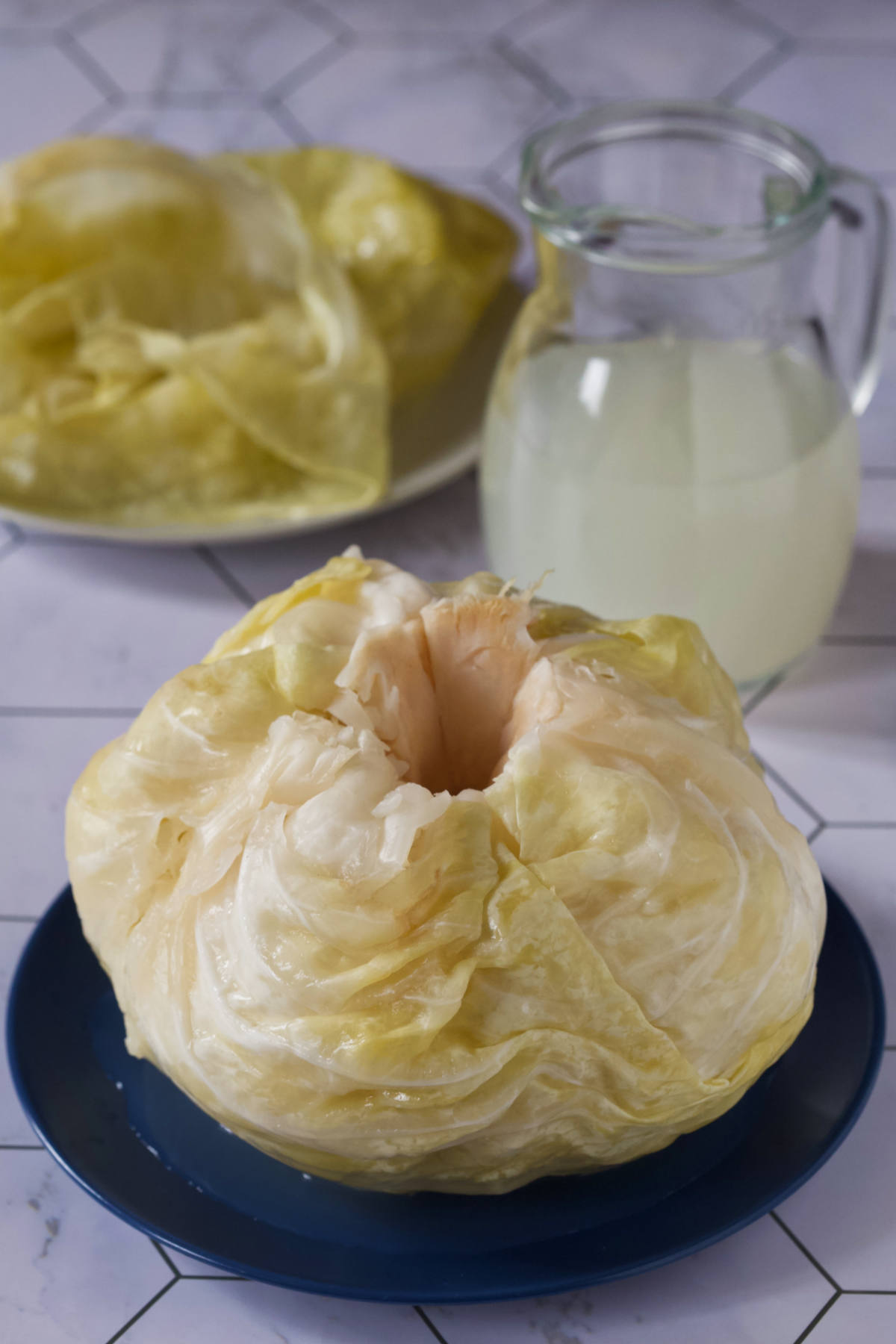
Jump to:
Background
Almost every household in the Balkans pickles, ferments, or makes preserves for zimnica, aka winter food. Everyone's favorite is kiseli kupus.
Known in the rest of the world as fermented cabbage, sour cabbage, or sauerkraut, this tangy delicacy is a winter must!
Fermented cabbage comes in different shapes. From shredded sauerkraut to whole cabbage heads, there is no wrong way to do kiseli kupus!
Our easy recipe will teach you how to pickle the whole cabbage head. As a bonus you'll also get the amazing kraut juice (rasol), long considered a fermented superfood.
What's more, this is a simple, centuries-old method for fermenting cabbage, and one you can master from the first batch.
Why You'll Love This Recipe
- More Options! Fermented whole cabbage heads are perfect for sarma rolls, salads, baked sauerkraut, or by themselves!
- Minimal Equipment! Only 2-3 things are needed, and you probably already have them!
- Probiotic from Heaven! Research is showing fermented foods to be the key to fortifying our antioxidant defense systems.
- Kraut Juice or Rasol! The main by-product of fermented cabbage heads is the superfood called kraut juice (brine, rasol)!
- Long Lasting! A big batch of fermented cabbage heads can last you through the winter!
Pickled vs Fermented
So, is this a recipe for pickling or a recipe for fermenting cabbage? Let's clarify the difference. According to Spicesinc:
Pickling involves putting food into an acidic brine to produce a sour flavor, whereas fermenting gives food a sour flavor without any added acid.
In the case of Balkan fermented cabbage heads (sauerkraut), fermenting and pickling definitions overlap.
Salt is added to cabbage heads to help create brine, something done for pickling. However, the cabbage helps co-create the brine as well, by fermenting.
What's more, the current local verb used for this method is "ukiseliti", translated as "to make sour," a catchall phrase for both pickled and fermented foods.
We'll use both terms throughout the text.
Conditions
Although not technically equipment, you'll need to meet two conditions to be able to make fermented cabbage (kiseli kupus).
- Cold Weather. Wait for the weather to cool down when you attempt to ferment cabbage.
- Think October through November in the Northern Hemisphere. - Good Fermenting Spot. A cold (but not freezing), dark, airy, space to leave your barrel to ferment.
- Some options are the shed, basement, storage with windows, an outside shaded kitchen, garage, shaded balcony, or a terrace in the shade, etc.
- Ideally, it's a drafty space that has a stream of air coming through relatively frequently. (Sauerkraut smell is powerful!)
Equipment
Here's all the 'fancy' equipment you'll need to make sour cabbage (kiseli kupus):
- A Barrel. One 14-16 gallon (50-60 liter) plastic bucket, barrel, or container, with a lid. (Two 7-8 gallons also work, but it's easier to do it all at once.) This size produces enough fermented cabbage for a smaller family to use over winter.
- Weights. To hold cabbage submerged in water (brine, rasol) you'll need to put something heavy on it. Examples: plastic bottles filled with water, weights, a big, cleaned rock (or a few), or a similar heavy waterproof object. (It has to fit under the lid.)
Ingredients
Only three ingredients are needed to make fermented cabbage (kiseli kupus). Everything else is optional.
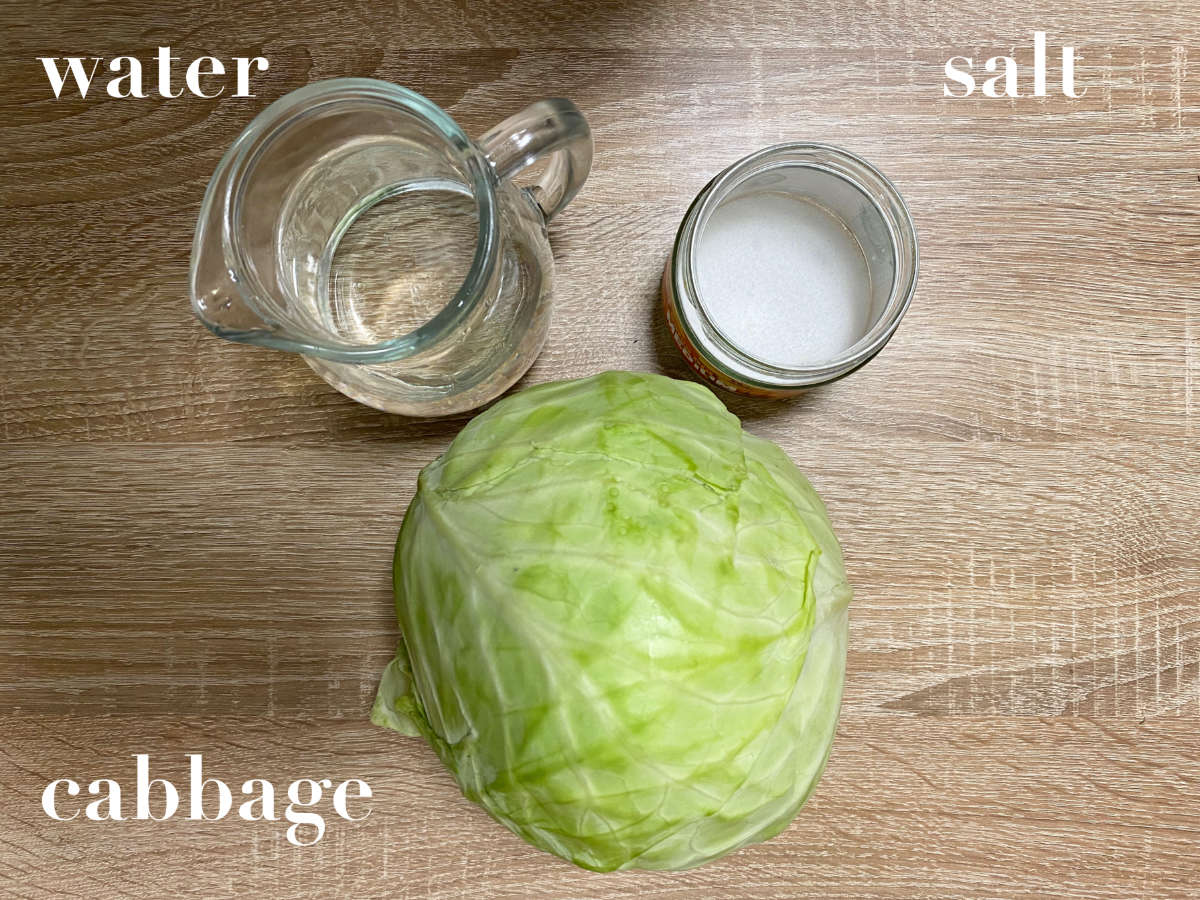
- Green Cabbage Heads: about 60-65lbs (about 27-30kg) whole green cabbage heads. Check that they have been recently picked, that they're healthy, hard, sturdy, and have no visible damage, or black spots.
- Salt: regular white table salt works best. Substitute with sea salt. You'll need about 2 pounds (1 kilogram).
- Water: If your tap water is drinkable, use it. Otherwise, substitute with filtered or bottled non-carbonated (regular) water.
Optional Ingredients
- Corn: one corn on a cob thrown into the fermenting barrel gives sour cabbage a nice yellow hue.
- Different seeds like peppercorn (this one is very popular), mustard seed, etc add to the taste, but only slightly.
- Then again, you can opt to do a whole fermented salad by adding peppers, carrots, broccoli, etc. This is called turšija, and here's our recipe.
Instructions
There are several ways to ferment whole cabbage heads (make kiseli kupus). Our recipe follows the simplest, classic method.
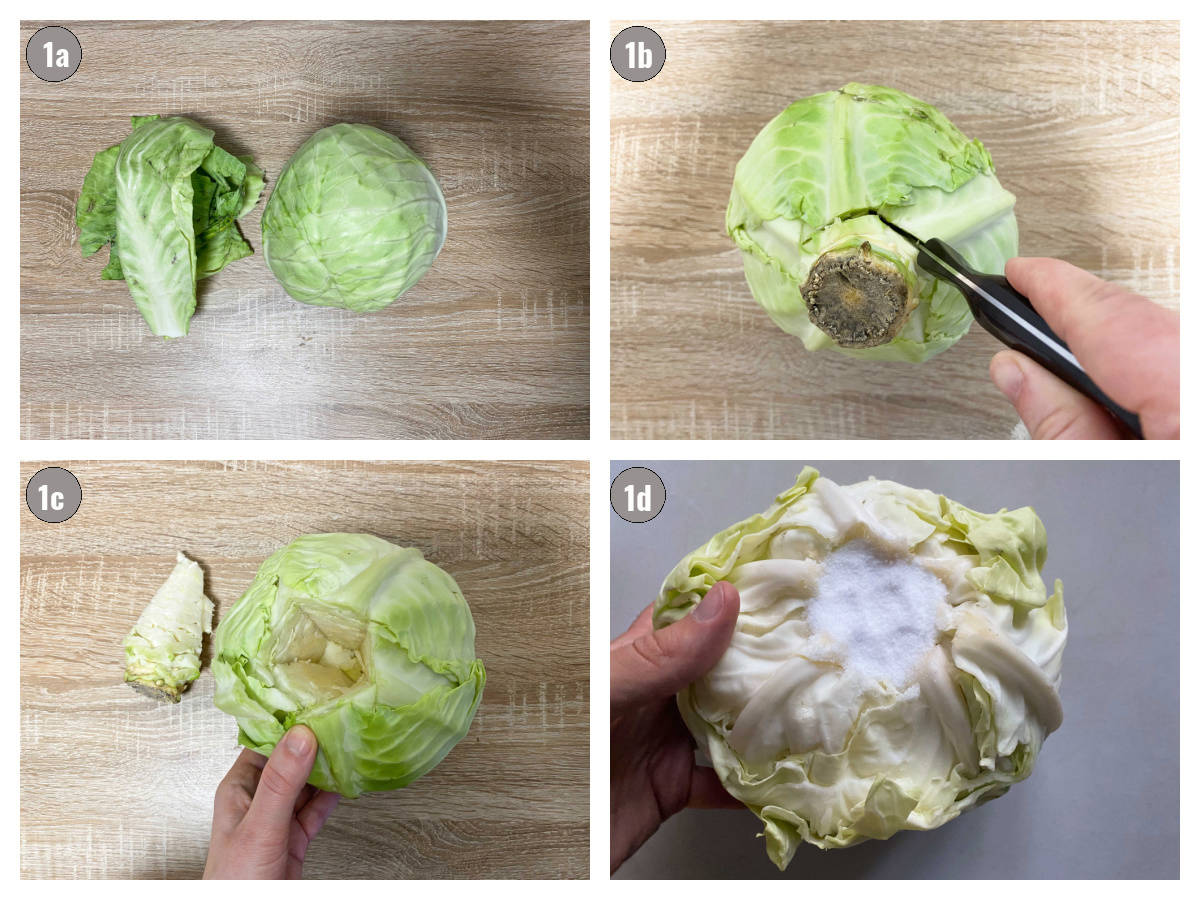
Step 1. Prepare the Cabbage. Before fermenting cabbage, check that your cabbage is actually good for fermentation. It needs to be fresh, recently picked, and sturdy. Remove outer leaves. Check there are no dark spots. Cut out the roots. Fill the root holes very, very generously with salt.
Step 2. Find Fermenting Space. Transfer the barrel to a dark, cool, airy place where it can be undisturbed for at least 6 weeks. (The easiest method is to transfer it to the fermenting spot when it's empty, and fill it up with ingredients on the spot.)
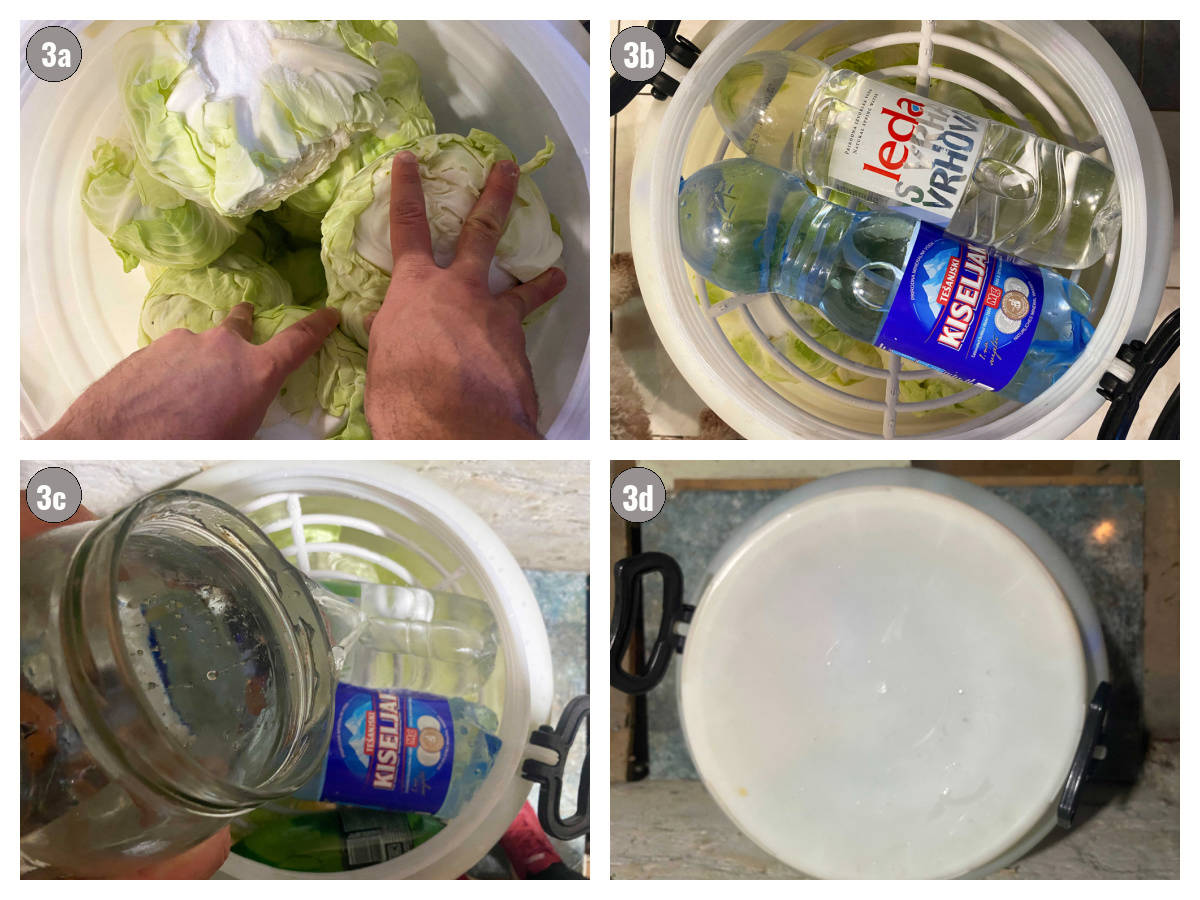
Step 3. Assemble Cabbage in the Barrel. Place the cabbage heads in the barrel. Push as many together as it will fit. They should be positioned extremely tightly together. (You can quarter a few cabbage heads and place them in between whole cabbage heads, also.) Place a heavy object(s) on top of the cabbage. Fill the barrel with water until it reaches 1-2 inches (2-4 centimeters) above the cabbage. Fasten the lid.
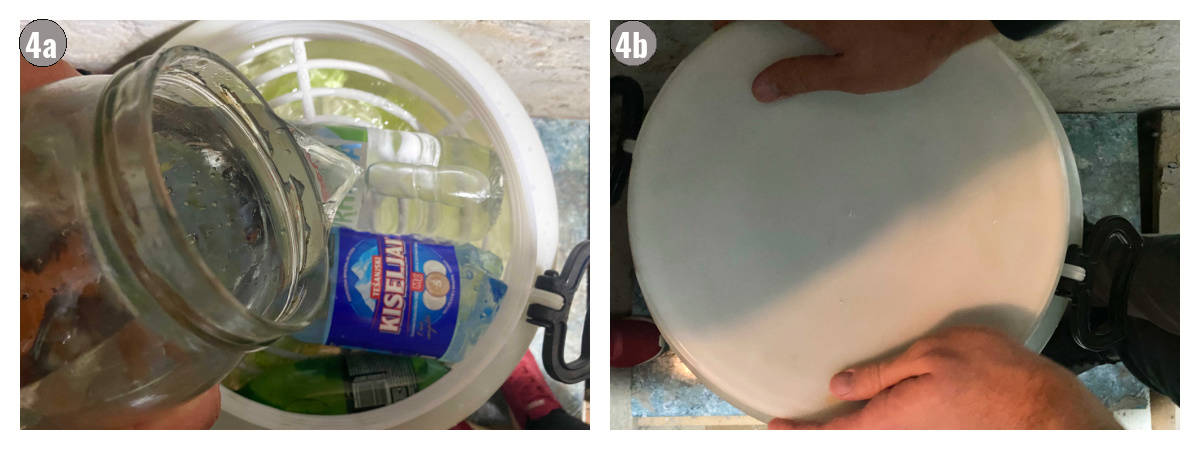
Step 4. Add More Water and Wait. About 2-4 days after placing the cabbage heads in the barrel, open it. The water level will lower by now (cabbage absorbs it). Add more water, so that it reaches about 1-2 inches (2-4 centimeters) above the cabbage (just like at the start of the process). Close the lid back up.
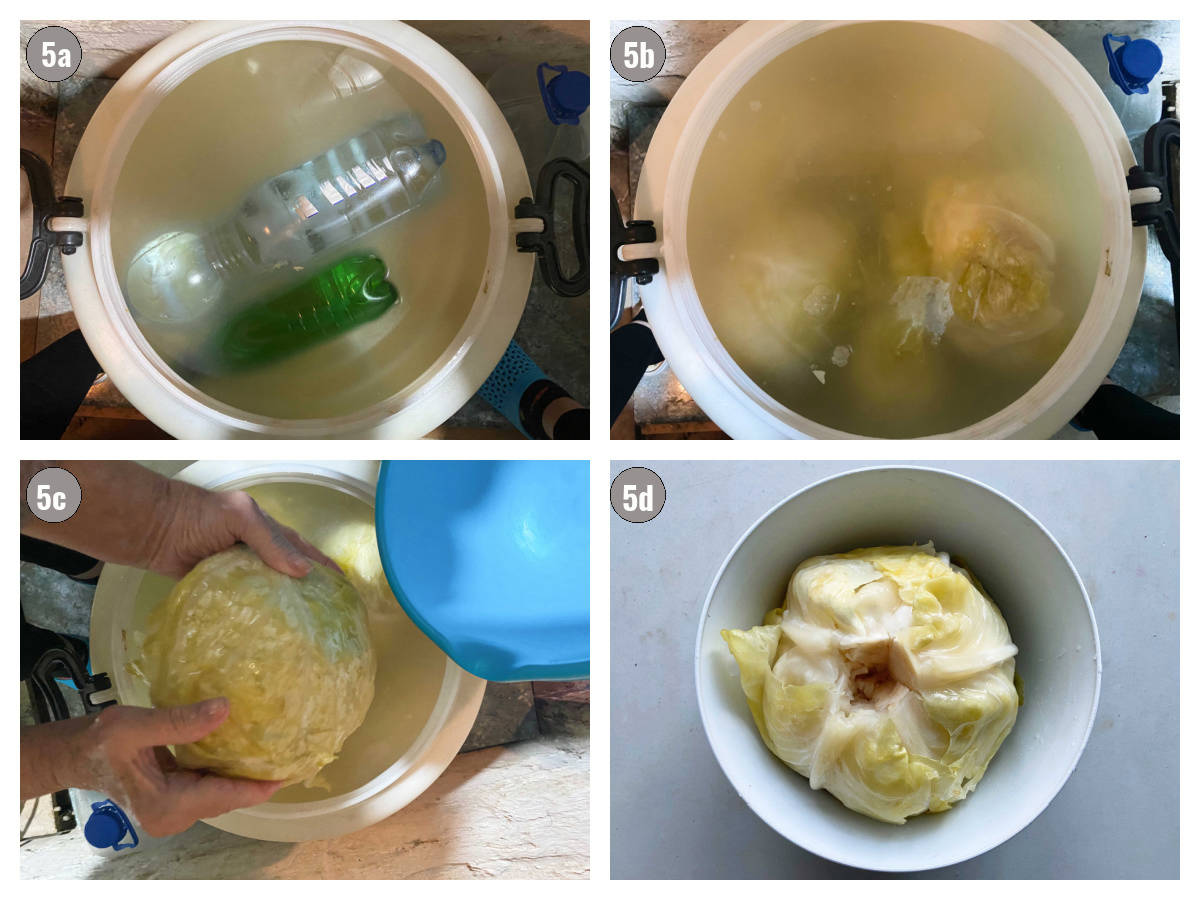
Step 5. Open the Barrel. About 6 weeks (40 days) later, open the barrel. Remove heavy objects, and check out the cabbage. The fermenting should be done by now. If the cabbage is not quite there yet, return the heavy objects, close the lid, and let the heads ferment for a few more days.
Optional step. You can check the cabbage before the end of 6 weeks, or once or twice in between. However, always make sure to return the heavy objects on the cabbage and to close and fasten the lid.
Signs Cabbage is Fermented
- The best method to check whether cabbage is fermented is to taste it. Kiseli kupus should be tangy, salty, and crunchy. If it's still not salty enough, let it ferment longer.
- In looks, fermented cabbage (kisseli kupus) should be sturdy, heavy with kraut juice, translucent, almost plastic-y, and just slightly yellow. (If it's mushy, or too yellow, it's gone bad!)
- Finally, the water (brine, kraut juice, rasol) should be a cloudy white, kind of like lemonade. (If you added corn on the cob, in color it'll be a little bit more yellow.)
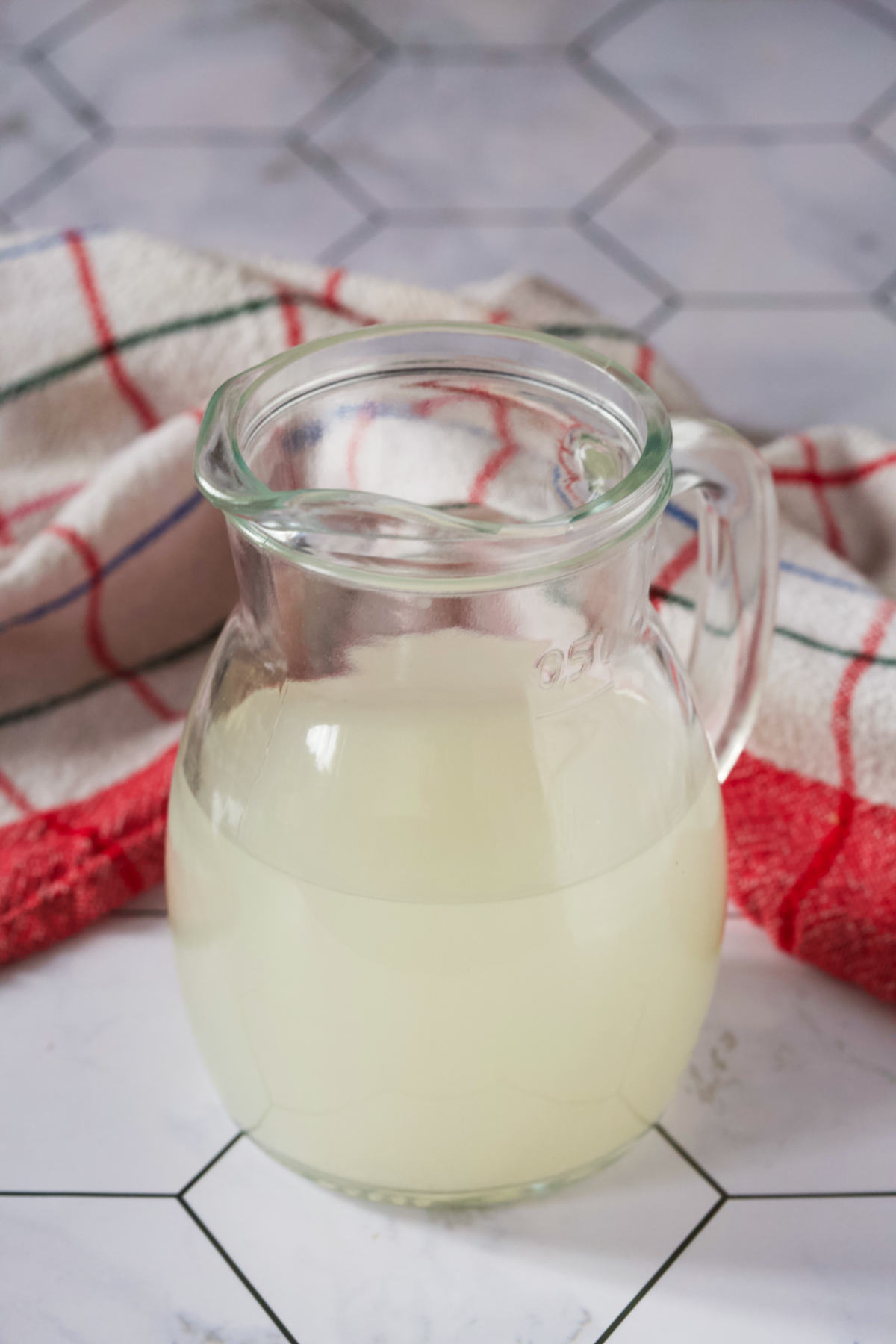
Kraut Juice or Rasol
Kraut juice, or rasol, has been consumed (in moderation) in the Balkans for decades, if not centuries. It's believed to:
- Be a great source of Vitamin C. (Perfect to fortify immunity during the long winter months.)
- Act as a bone fortifier. (Containing Vitamin K2 which is great for bone strength.)
- Be a great hangover cure. (We can vouch for this!)
- Be a good constipation cure. (Can't go? Drink a cup of rasol and wait.)
- Finally, it's thought to aid weight loss. (Like ACV, it is believed that sauerkraut juice helps prevent huge insulin spikes.)
Handling
Taking fermented cabbage out of the barrel:
- Whole Sour Cabbage Heads. Take the lid off the barrel, remove heavy objects, and take out however many heads of fermented cabbage you need. Transfer them to a big bowl right away as they'll be dripping with kraut juice (brine, rasol).
- Kraut Juice (Rasol). If you need kraut juice, you can use the kraut juice that drips out of the fermented cabbage into the bowl. Alternatively, grab as much juice as you need from the barrel, and transfer it to a bottle that you'll keep in the fridge.
- Close the Lid. Once you're finished taking out sour cabbage or kraut juice, return heavy objects on top of the remaining cabbage, and close the lid. (Sometimes cabbage heads 'swim up' and they need to be submerged.)
Serving and/ or using fermented cabbage for a dish:
- But First! Before using sour cabbage for a dish, taste it. If it's too salty, or too tangy, wash it out under lukewarm water. (We like kiseli kupus really sour, but you may not.)
- Salads. If planning to serve fermented cabbage as a salad, or eat by itself, remove one to two outer leaves and discard them. Shred the rest with a knife or a grater.
- Sour Cabbage Rolls (Sarma). If using it for sarma, use whole sour cabbage leaves. Again, discard one or two outer leaves.
- Leftovers. If you have leftover fermented cabbage, place it in an airtight container and keep it in the fridge for up to 2-3 days. Kiseli kupus smell packs a punch, so be warned!
Freezing fermented cabbage:
A big batch of sauerkraut (kiseli kupus) will last you throughout the winter. If you want to keep some for later on in the year, this is how to freeze it.
-Big Freezer. If you have a big freezer, freeze the whole fermented cabbage head (or more), in a sturdy freezer bag. Freeze them for up to 6 months.
-Salads. If planning to use sour cabbage for salads, and baked sauerkraut, shred or grate one or two sour cabbage heads, and place them in a freezer bag. Transfer to the freezer for up to 6 months.
-Sour Cabbage Rolls (Sarma). If freezing sour cabbage for sarma, freeze the entire leaves. Remove leaves from a cabbage head, stack them in piles of 5-10, and then roll the stacks up. Place rolls in a freezer bag. Transfer to the freezer for up to 6 months.
Thawing fermented cabbage:
- A few hours before you plan to use fermented cabbage, take it out and let it thaw at room temperature. Use it for the recipe. Keep leftover fermented cabbage (kiseli kupus) in the fridge in an airtight container or a freezer bag.
Recipe FAQs
As always, consult with your doctor(s) and nutritionist first!
That said, fermented foods are an indispensable part of Balkan cuisine. This food group is more or less consumed by everyone, including (in moderation) pregnant women.
In our family, all women ate sour cabbage (kiseli kupus), sour salads, sarma, etc. while pregnant. There have been no problems.
No.
Fermentation creates lactic acid, acetic acid, and CO2, all known to fight off pathogens such as Clostridium botulinum (the bacteria that causes botulism).
You can easily recognize bad sour cabbage by its color (overly yellow) and the texture (too mushy). Also, it may smell like rot as opposed to fermentation.
Even if you ferment cabbage for years, a bad batch can happen to you. Learn what you can from it, and move on.
Usually, the cabbage head was bad to start with. Maybe it started to rot in one little spot and the fermentation sped up the process. Like apples, after one cabbage head goes bad, the others do too.
You can somewhat prevent this by being vigilant when removing the outer leaves before fermentation. Check for any dark spots or inconsistencies. Cut out what you can, or, if in doubt, get rid of the entire cabbage head.
Additionally, the fermentation process itself may have had some hiccups. Perhaps it fermented for too long, or the season is unusually warm.
In either case, discard the head and you should be fine. In some instances, you may have to discard the whole barrel of cabbage heads. Luckily, the process to make them is super easy, so making a new batch is simple.
Some people do make brine ahead of fermenting sour cabbage (kiseli kupus).
However, you have a bigger chance of the cabbage going bad by making the brine separately. Placing the salt in the hole where the cabbage root was is a better prevention method.
No. Don't overcomplicate the process that's been here forever.
People have been fermenting food for eight thousand years. Do you think they had pH strips in 6000 BCE? They did not.
Cabbage Dishes
Additionally, here is a collection of other cabbage dishes we love.
Thoughts?
Lastly, if you made Fermented Cabbage or Homemade Saueurkraut Whole Heads, Sour Cabbage Heads (Kiseli Kupus) and liked it, please consider giving it a ⭐️⭐️⭐️⭐️⭐️ (5-star) rating. This helps others find the recipe more easily!
Also, feel free to leave a comment (I read each one!), and don't forget to tag a photo #balkanlunchbox, or us @balkanlunchbox, on IG.
Prijatno, Dobar Tek, and Bon Appetit!
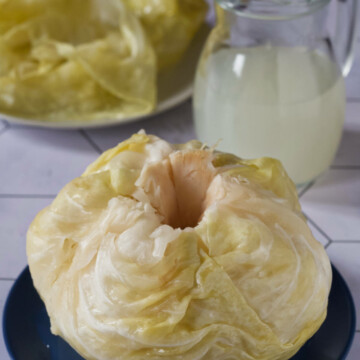
Fermented Cabbage Heads and Kraut Juice (Kiseli Kupus i Rasol)
Equipment
- One 14-16 gallon (50-60 liter) barrel, or plastic bucket, or a container with a lid. Two 7-8 gallons also work.
- Weights or a heavy object. Anything will do. Plastic bottles filled with water, weights, a big, cleaned rock (or a few), or a similar heavy, waterproof object.
Ingredients
- 60-65 pounds green cabbage heads for scale, one cabbage head is usually about 2 pounds (1kg)
- 1-2 pounds salt substitute with sea salt
- water tap if clean, filtered, or bottled (non-carbonated) water
- (Optional) one corn on a cob
- (Optional) 2-3 handfuls of peppercorn or mustard seed
Instructions
Prepare the Cabbage
- Take a cabbage head, and check that it's fresh, recently harvested, and sturdy. Remove three or four outer leaves, and check further that there are no dark spots on the cabbage, and/ or other damage. (If there are and they're small, cut them out. If they're large and deep, discard them, and start working on another cabbage head.)
- Carefully cut out the root, avoiding cutting too much of the actual cabbage head, and also avoiding cutting through to the other side of the cabbage. An easy way to do this is to make a ‘pentagon’ or ‘hexagon’ around the root with the knife. At first, make shallow cuts in the shape of a pentagon, and as you circle around, stab the pentagon a little bit deeper each time. At some point, it’ll get easier and easier to cut around until you’ll be able to easily pull out the root with your hand. Fill the root hole generously with salt. Push the salt in with your fingers and add more if possible.
- Repeat the previous steps for all cabbage heads.
Find a Fermenting Spot
- The cabbage will be fermenting for at least 6 weeks (about 40 days), and it's important to find a good fermenting spot. This type of fermentation requires cool or cold temperatures (not freezing though!), and shade or dark. Additionally, a good spot will have a stream of air coming through frequently, or some type of a draft, due to the strong fermenting whiff. Think the shed, basement, storage with windows or air supply, garage, or shaded balcony.
- Transfer your barrel to the fermenting spot while it's empty, and fill it with ingredients on the spot.
Assemble the Cabbage
- Transfer the cabbage heads into the barrel. (Sides with the holes and salt should be up.) Freely apply some pressure as you are pushing them together, and place in as many as they'll fit. Cabbage should be positioned extremely tightly together. (You can even quarter a few cabbage heads to put in the smaller empty spaces.) At this point, add any additional optional ingredients.
- Place your weight(s) on top of the cabbage. At this point fill the barrel up with water until it reaches 1-2 inches (2-4 centimeters) above the cabbage. Fasten the lid well. Let it rest for 2-4 days.
Add More Water and Wait
- About 2-4 days later, open the barrel. The cabbage will have absorbed some of the water, and its level will be lower than before. Refill the water so that it's once again at about 1-2 inches (2-4 centimeters) above the cabbage. Fasten the lid and let it rest for 6 weeks or about 40 days.
(Optional Step)
- We don't do this step, and are proud to say that our cabbage has turned out great almost always. You're welcome to do it, but keep it to the minimum!
- Some people check the cabbage before the 40 days is up to see whether it has fermented. Others like to add a little more water here and there. The most important advice is to always return the weight(s) on the cabbage and to close the lid well.
Open the Barrel
- After about 6 weeks (40 days), open the barrel. Remove the weight(s), and take out a cabbage head to see whether it's fermented. Remove one or two outer leaves and then taste it.
- Cabbage that's fermented well should taste tangy, salty, and crunchy. (The saltiness is usually the best-determining factor.) In looks, it should be translucent, almost like plastic, and just slightly yellow. The kraut juice (rasol) should be the color of lemonade. (If you added corn on the cob, it'll be a bit more yellow.) Check below for signs it has gone bad.*
- If it's not there yet, return it to the barrel, put the weight(s) on top, close the lid, and let it ferment for a few more days to a couple of more weeks.
Handling
- Taking out of the barrel: when ready to use fermented cabbage, take the lid off the barrel, remove heavy objects, and take out however many cabbage heads as you'll need. Transfer them to a deep bowl immediately as they'll be dripping with kraut juice (rasol). Also, take as much kraut juice as you need as well, or use whatever drips out of the cabbage heads (they hold a lot of it). Transfer the juice to a bottle and keep it in the fridge. After you're done taking what you need out of the barrel, return the weight(s) on top, and fasten the lid.
- Serving and/ or using fermented cabbage for a dish: before you use sour cabbage, taste it. If it's too salty for your taste, wash it out under lukewarm water. Remove outer 1-2 leaves, and use the rest for your chosen dish.
- If you have leftover fermented cabbage, place it in an airtight container and keep it in the fridge for up to 2-3 days. Kiseli kupus smell packs a punch, so be warned!
- Freezing fermented cabbage: freeze whole heads (if you have a big freezer) in a freezer bag for up to 6 months. However, if you plan to use sour cabbage for salads only, shred or grate a desired amount, put them in the freezer bags, and transfer them to the freezer for up to 6 months. Finally, if freezing to use in sour cabbage rolls (sarma), freeze whole leaves. Simply remove leaves from a cabbage head, stack them in piles of 5-10, and then roll the stacks up. Place rolls in a freezer bag. Transfer to the freezer for up to 6 months.
- Thawing fermented cabbage: a few hours before you plan to use it, take it out and let it thaw at room temperature. Use it for the recipe. Keep leftovers in the fridge in an airtight container or a freezer bag.
Notes
- Bad Cabbage:
- Nutrition Information:

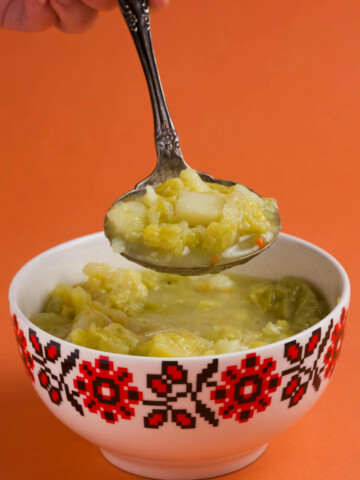
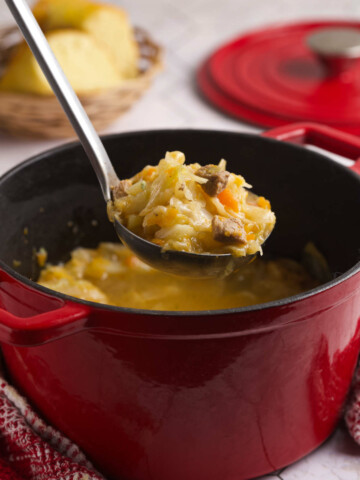

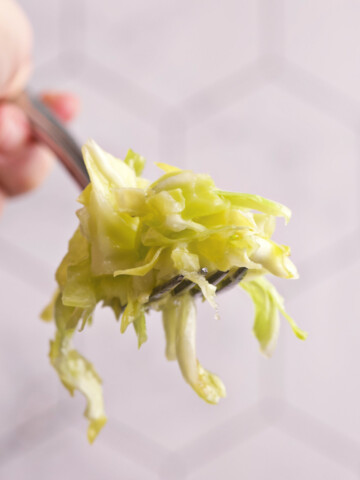
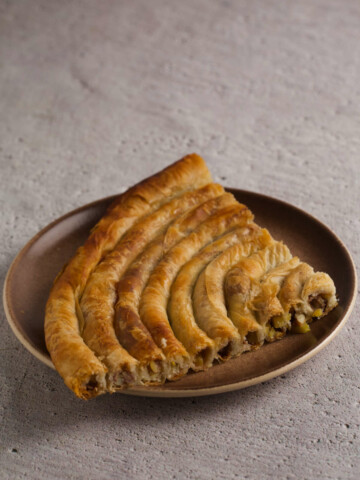
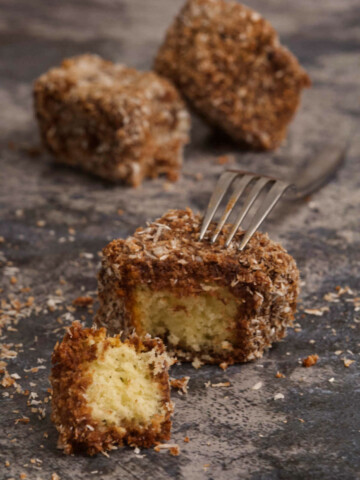


Kristi @ Inspiration Kitchen says
I love cabbage and would've never thought to do this! Come to think of it, you have me crazing cabbage now. 🙂
aida says
Glad to hear it! And honestly, feel free to leave it out for a shorter period of time (5 or 10 days). I haven't had problems with it, although I do like it very sour so I usually leave it out longer.
Emily says
Oh, I have The Art of Fermentation on my list of books to read right now! I've always been so intimidated by the whole process.. love your step by step photos!
aida says
Thanks Emily! Glad it helps. Don't be intimidated, it's super simple. Salt, water, cabbage, and you're good to go! If it doesn't work out, just get another head of cabbage, tweak the process a little bit (for example: longer or shorter period for fermentation) and try again.
Phi @ The Sweetphi Blog says
Wow, love this recipe (and your photos are gorgeous)! My mother loves fermented cabbage, and I love how you showed how to make this, I'm totally going to try this!
aida says
Lovely! Let me know how it goes.
Matea says
Thanks for this recipe! I've contemplated fermenting cabbage but didn't know how to! Nice photos 🙂
aida says
Thanks Matea! Let me know if you do and how it turns out.
Peter says
So I love kupus though it's def a far second to shopska which sadly I find near impossible to make in the US as never found proper sirene (non creamy, i.e. the kind you can shred) outside a small market in Cleveland but the question I have is what makes this different than sauerkraut?
And I mean that in a serious manner, not poking fun. Sauerkraut is basically an identical recipe yet much more sour whereas in Bosnia the kupas was always more mellow and sweet so curious why? Different type of cabbage? Just the length of ferment?
aida says
Good question. I think they're pretty similar, depending on whose you try. I agree - it's most likely the shorter amount of prep time that makes it less sour. As far as the sir (cheese) for sopska salata, yes, it's made with either sheep or cow milk cheese, unpasteurized. You probably won't find it in the US unless you have your own cows/ sheep. Some people find they like it with feta, so try that.
Mary Lou Surgi says
Hello, I hope you are still here! I love this fermented cabbage--I have been eating it almost every day while I am temporarily living in Albania. Of course, I usually buy it! But, I want to be able to make it when I return to the US later this year, so I have followed your recipe and it is just perfect. My question is about that round, white thing like a wheel that you put in the jar to keep the cabbages below the brine. I have seen it or something similar in other videos.
My question is, what is it called? And do you know where it can be bought--on-line or in markets in Europe??
Just hoping you can help me solve this mystery. Thank you.
Aida says
Hey May,
I know exactly what you're referring to, but I don't know what it's called. However, you can use something heavier like a clean rock or similar to keep the cabbage down.
Good luck!
Aida
Polack says
I wonder if you can use a crumpled up piece of parchment paper on top of the jar to keep the cabbage submerged. Even cutting popsicle sticks to fit the jar and packing them on top of the parchment paper to be on the safe side
Aida says
Cabbage heads are quite strong, especially when they're trying to move up in the barrel during fermentation. Parchment paper and popsicle sticks are too weak.
A few 2 liter plastic bottles work well.
Natalie Cassin says
Why not purple? Curious 😉
Aida says
Not sure. Germans do it. Here, purple cabbage is either in a salad, or stir fried.
Deb says
What about a moldy smell? Is the batch bad?
Aida says
Hi Deb,
Fermented cabbage smells very strong due to fermentation. As far as a moldy smell - it could very well be that it went bad. The best way is to test it. If the cabbage is crunchy and sturdy and a little tough then it's good to go. However if it falls apart in your hand, turns a little yellowish, and is mushy then it's no good. (Make sure to add lots of salt when you ferment it next time.) Does that help?
Nicole Artukovich says
Love Kupus! Usually make it this time of year in large crocks in the garage where is stays cool. Not cool enough right now in California but getting there. I made a batch in my counter top crock. I just looked and its a little foamy on the top. What is this? Is it bad?
Aida says
Hi Nicole!
If you've put enough salt and water to cover the cabbage you should be fine. The foam is formed by fermentation. You can remove it.
Polack says
Hi...I am wondering if sour cabbage leaves can be processed in a hot water bath in quarts. My freezer is jam packed and no room for the leaves. Have seen lots of recipes for canned sour kraut but not having much luck finding info for canning the leaves. Would it be the same process as for kraut??
Aida says
Hi Polack,
we haven't done this, and we've never seen it done, so we can't advise you. If you do, let us know how it turns out.
Good luck!